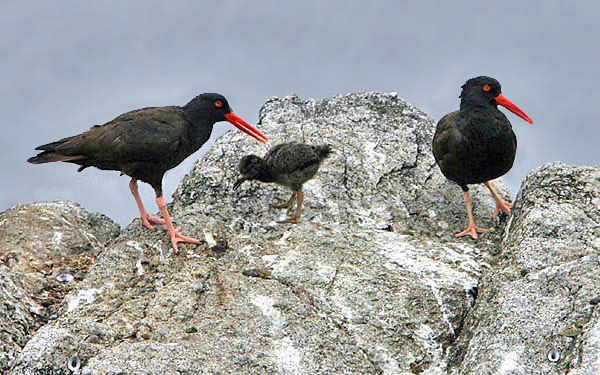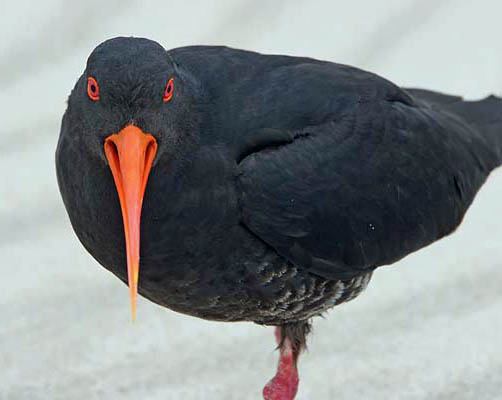
a web page by Don Roberson |
 |
||
OYSTERCATCHERS Haematopodidae |
||
|
||
Black Oystercatchers are entirely restricted to the rocky shore: searching food at low tide (limpet acquired in photo, left) and roosting at high tide. When nesting, our oystercatchers are very territorial, but in winter they often roost in flocks, and are sometimes joined by dispersants from as far away as the Farallon Islands (based on banded birds). |
||
|
||
Almost half of the world's oystercatchers are black to blackish birds, and so was the now-extinct Canarian Oystercatcher H. meadewaldoi (not seen since 1940s). These are primarily birds of rocky shorelines, filling the traditional oystercatcher niche of eating mussels and limpets. They tend to be entirely resident, and thus have one of the narrowest ranges in the world, restricted to the narrow tideline zone of the coastal littoral. Examples of other all-black species are African Oystercatcher (below left) and Sooty Oystercatcher of Australia (below right). Some of these all-black oystercatchers are so similar that various authors have from time to time lumped various species together. For now, though, they are all split as species. |
||
|
||
 |
||
| The world has seven black-and-white oystercatchers, including the pied morph of Variable Oystercatcher. The species in flight (above) is Pied Oystercatcher; it occurs on coasts around all of Australia. The strikingly long-billed species (below left, in a fine shot by Murray Lord) is South Island Oystercatcher. The latter is a breeding bird of South Island, New Zealand, but this photo was taken at Sydney, Australia, where it is a vagrant. The adds a species to the Australian list, as otherwise there are just two resident oystercatchers — Sooty and Pied. | ||
Eurasian Oystercatcher has the broadest range of habitats, frequenting flooded fields, lake shores, and pasturelands well inland. This bird was foraging with Dunlin Calidris alpina in the rain on Dutch lowlands.
It also has the widest land range of all oystercatchers, breeding across Eurasia and wintering south to NW & NE Africa, the Middle East, and India to China. Here (below) is a small flock of wintering Eurasian Oystercatchers on the Persian Gulf, along with various migrants waders and terns. |
||
 |
||
 |
||
In North America, the east and gulf coasts are inhabited by American Oystercatcher (above), a species that is widely distributed along sandy beaches and tidal mudflafts, as well as rocky shores. Its range includes Central and South American shores plus various Caribbean islands and the Galapagos. Northern populations move south in winter. By contrast, Black Oystercatcher is a resident entirely restricted to the rocky shore. Because habitat is so narrow and so limited, few pairs can inhabit the same stretch of coastline. An interesting situation developed off western Baja California, Mexico, where collectors in the late 1800s removed most of the oystercatcher populations: both Black and American Oystercatchers occurred there without apparent interbreeding. With the tideline niche now open, immigrants from the north (Black Oystercatchers) and the south (American Oystercatchers of the race frazari) begin filling the habitat. With much less choice in mate selection under these circumstances, significant hybridization between the species occurred, and the zone is still not entirely settled (Jehl 1985). Accordingly, vagrant American Oystercatchers in coastal southern California to this day are scrutinized using the "Jehl index" — a scoring system of ten characters (wingstripe, rump pattern, etc.) — that separates normal variation from apparent introgression (see Roberson 1993 for application of this index to particular records).
The last currently-accepted pied species is the Magellanic Oystercatcher H. leucopodus from the southern end of South American. There is still no uniform agreement on how many species of oystercatchers there are. Hockey (1996) provides some arguments why the Sooty Oystercatcher H. fulginosus of Australia should be split into two species (creating the "Spectacled Oystercatcher H. opthalmicus") and why the Galapagos Is. birds (galapagensis) should be separated from the American Oystercatcher. His arguments have interesting elements, and we may yet see two more species of oystercatchers. |
||
Photos: The three photos at the top of this page of Black Oystercatcher Haematopus bachmani were taken at various locations at Pebble Beach and Pacific Grove on the Monterey Peninsula, California, USA, on 7 July 2018 (group), 26 July 2014 (with limpet), 10 Mar 2004 (mating), and 26 Aug 2006 (pair with chick). The Variable Oystercatcher H. unicolor was at Pakiri Beach, North Island, New Zealand, on 15 Nov 2009. The African Oystercatcher H. moquini was West Coast NP, South Africa, on July 2005. The Sooty Oystercatcher H. fuliginosus was at Cheyne Beach, West Australia, on 9 Aug 2008. The Pied Oystercatcher H. bachmani was at Luggage Beach, Brisbane, Qld., Australia, on 3 Sep 2016. Murray Lord photographed the vagrant South Island Oystercatcher H. finschi at Sydney, NSW, Australia, on 10 Mar 2015. The lone Eurasian Oystercatcher H. ostralegus with Dunlins was shot in the rain on Texel, the Netherlands, in Oct 199x, and the flock of Eurasian Oystercatchers, with waders, was at Khor al Beida beach, UAE, in March 2001. The beach-running American Oystercatcher H. palliatus was near Lima, Peru, on 26 Nov 2014, and the two vagrant American Oystercatchers were photographed by Jeri M. Langham at the Salton Sea, California, 24 Aug 1977. All photos © Don Roberson , except those credited to © Murray Lord and Jeri M. Langham, as credited, and used with permission; all rights reserved. Bibliographic note: There is no "family book" per se, but a fine introduction to this family, with some engaging photos, is in Hockey (1996). Oystercatchers are included in many books featuring shorebirds — Hayman et al. (1986) was the one mentioned in the first posting of this Oystercatcher page — but there are many other additions to the literature on the Charadriformes since then. Literature cited:
|
 The Oystercatchers are a small family of shorebirds that have specialized bills for dealing with oysters, mussels, and limpets. All oystercatchers are similar in overall size and shape, and all are assigned to the single genus Haematopus. There is a black species, or a pied species — and sometimes both — on most shorelines at temperate latitudes around the world. Where I live on the Monterey Peninsula, California, Black Oystercatcher (above, left, and below) is conspicuous on our rocky shores by its loud cries, particularly in the spring when pairs chase each other about and then land, bowing to each other in courtship. Courtship leads to copulation (below left) and that can lead to one or more baby oystercatcher (below right). A multi-year study of our local oystercatcher has been consistent with other research: raising young on the rocky shore of a wave-pounding ocean is hard. Our annual rate for successful fledging of even one youngster is just 15-20%. All the rest are lost to predators, especially egg-robbing gulls, and disturbance by tourists.
The Oystercatchers are a small family of shorebirds that have specialized bills for dealing with oysters, mussels, and limpets. All oystercatchers are similar in overall size and shape, and all are assigned to the single genus Haematopus. There is a black species, or a pied species — and sometimes both — on most shorelines at temperate latitudes around the world. Where I live on the Monterey Peninsula, California, Black Oystercatcher (above, left, and below) is conspicuous on our rocky shores by its loud cries, particularly in the spring when pairs chase each other about and then land, bowing to each other in courtship. Courtship leads to copulation (below left) and that can lead to one or more baby oystercatcher (below right). A multi-year study of our local oystercatcher has been consistent with other research: raising young on the rocky shore of a wave-pounding ocean is hard. Our annual rate for successful fledging of even one youngster is just 15-20%. All the rest are lost to predators, especially egg-robbing gulls, and disturbance by tourists.

 Half-a-world away, another black-robed taxon is New Zealand's Variable Oystercatcher (right). There are small difference in eye and leg color, and a few pale edges to belly feathers, but they are more similar than different. [Variable Oystercatcher is unique in having all-black or nearly all-black morphs, like this one; black birds with white bellies and barring at the demarcation zones; and very black-and-white birds elsewhere.]
Half-a-world away, another black-robed taxon is New Zealand's Variable Oystercatcher (right). There are small difference in eye and leg color, and a few pale edges to belly feathers, but they are more similar than different. [Variable Oystercatcher is unique in having all-black or nearly all-black morphs, like this one; black birds with white bellies and barring at the demarcation zones; and very black-and-white birds elsewhere.] 

 As a nation, New Zealand now hosts the most species. Traditionally there was just one — the Variable Oystercatcher. Many lists had included South Island Oystercatcher within the races of the Eurasian Oystercatcher H. ostralegus. Hockey (1996) agreed that Chatham Oystercatcher H. chathamensis of the Chatham Islands be split from Variable, and thereby create an endangered species.
As a nation, New Zealand now hosts the most species. Traditionally there was just one — the Variable Oystercatcher. Many lists had included South Island Oystercatcher within the races of the Eurasian Oystercatcher H. ostralegus. Hockey (1996) agreed that Chatham Oystercatcher H. chathamensis of the Chatham Islands be split from Variable, and thereby create an endangered species.
 In contrast to the narrow niche of the black oystercatchers, various pied species are more catholic in habitat choice. Some wandering occurs in these black-and-white species as northern populations withdraw in winter. These particular American Oystercatchers (two birds at right in a nice shot by Jeri M. Langham) were spectacular vagrants to the Salton Sea: three were discovered at Salton City, Imperial Co., California, on 14-19 Aug 1977, and then rediscovered on the other side of the Sea at Salt Creek State Beach, Riverside Co. from 20-30 Aug (where this photo was taken). Any American Oystercatcher is a very rare vagrant in California and these, inland at "the Sea," represent the only record ever recorded there.
In contrast to the narrow niche of the black oystercatchers, various pied species are more catholic in habitat choice. Some wandering occurs in these black-and-white species as northern populations withdraw in winter. These particular American Oystercatchers (two birds at right in a nice shot by Jeri M. Langham) were spectacular vagrants to the Salton Sea: three were discovered at Salton City, Imperial Co., California, on 14-19 Aug 1977, and then rediscovered on the other side of the Sea at Salt Creek State Beach, Riverside Co. from 20-30 Aug (where this photo was taken). Any American Oystercatcher is a very rare vagrant in California and these, inland at "the Sea," represent the only record ever recorded there.